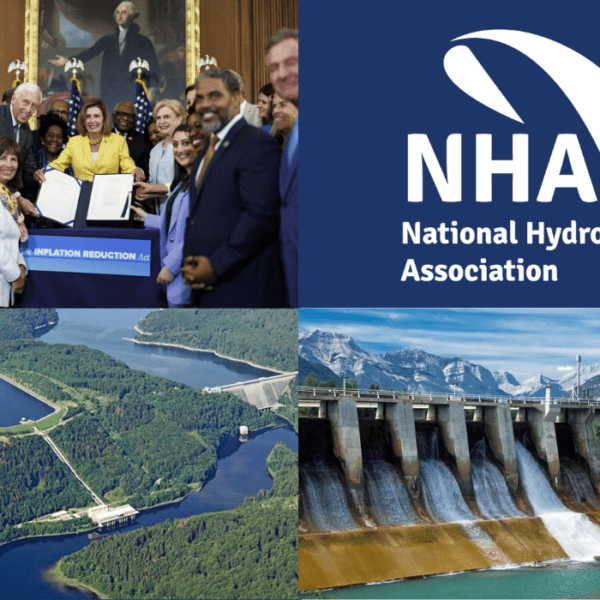The Federal Energy Regulatory Commission (FERC) has issued an NOI – a Notice of Inquiry – requesting comments on whether changes are necessary to its financial assurance practices for hydroelectric projects.
Before recommending any changes, it is helpful to first examine existing practices and how they function.
Providing Background
At least as early as the 1990s, FERC has required submission of financial information to protect against inadequate funding of hydroelectric projects. This practice has evolved to ensure that funds are available for construction, operation, and maintenance, with the level of detail determined on a case-by-case basis.
As FERC states in the NOI, it is ultimately the licensees’ financial responsibility to comply with the terms of the license. Fortunately, the overwhelming majority of FERC-regulated hydropower projects are compliant, in good standing, and do not require financial assurance. However, there are extremely rare instances of non-compliance where even civil penalties or criminal prosecution fail to conjure up funding for safety or environmental improvements. To help avoid these rare circumstances, FERC applies a financial test for both original licenses prior to construction and for license transfers.
The remainder of the article provides examples to clarify how FERC’s financial tests work in practice. For both original licenses and license transfers, two examples are provided: one example where FERC found the initial financial test was sufficient and one example where FERC found the financial test necessitated additional assurance.
These examples demonstrate that FERC has and uses its authority judiciously to require financial assurance on a targeted, case-by-case basis.
Only gluttons for punishment will read on.
How FERC’s Financial Tests Work in Practice
1. ORIGINAL LICENSES:
A. The Financial Plan is Sufficient = Red Rock Hydroelectric Project (P-12576)
The Red Rock Hydroelectric Project (Red Rock Project) is a 36-MW project located on a U.S. Army Corps of Engineers dam in Marion County, Iowa, which completed construction in 2020. The project was financed by the Western Minnesota Municipal Power Agency (WMMPA).
FERC required WMMPA to submit a financing plan 90 days prior to construction to demonstrate WMMPA had acquired the funds to construct the project. This is a standard article included in original licenses:
“Article 305. Project Financing Plan. At least 90 days before starting construction, the licensee shall file with the Commission, for approval, three copies of a project financing plan. The plan must show that the licensee has acquired the funds, or commitment for funds, necessary to construct the project in accordance with this license. The licensee shall not start any project construction or ground-disturbing activities that are inseparably associated with the project, before the project financing plan is approved.”
WMMPA submitted a financial plan which FERC deemed sufficient:
“The licensee’s plan includes a combination of equity funding, short-term financing through a Revolving Credit Agreement, and long-term financing through the issuance of tax-exempt debt. The licensee plans to utilize the equity funding prior to drawing funds from the Revolving Credit Agreement, and to collect the interest during construction costs through its rates, instead of using additional debt. The long-term debt will be issued during the first half of 2014, and will be used to pay the balance of the Revolving Credit Agreement and fund the remaining construction costs.”
The project is expected to begin power generation this year, providing baseload, carbon free electricity to 18,000 homes and businesses in 61 communities in Iowa, Minnesota, North Dakota, and South Dakota.
B. Additional Financial Assurance Is Necessary = Marseilles Lock and Dam Hydroelectric Project (P-13351)
The under-construction Marseille Lock and Dam Hydroelectric Project (Marseilles Project) will be a 10-MW project on a U.S. Army Corps of Engineers dam in LaSalle County, Illinois.
In FERC’s order issuing an original license for the Marseilles Project, FERC included the same financing plan article as can be found for the Red Rock Project. The applicant provided the financial plan, which FERC approved.
However, FERC also notes in the license order that the Marseilles Project’s primary representative is the representative of the Sanford Hydroelectric Project in Michigan, which had a history of non-compliance (and would later go on to fail in 2020):
“Mr. XXX XXXXXX is also the primary licensee representative for the licensed Sanford Hydroelectric Project No. 2785 where insufficient funding was given as the reason for failing to make timely dam safety repairs ordered by the Commission’s Chicago Regional Engineer… In addition, we have continually needed to remind Mr. XXXXXXX of his license obligations.”
As a result, FERC includes an additional license article requiring financial assurance:
“Article 316. Financial Assurance Plan. Within 120 days from the issuance date of this license, the licensee shall file, for Commission approval, a Financial Assurance Plan that identifies those project facilities that would be removed, secured in-place, or otherwise modified to ensure public safety and any other measures needed to protect environmental resources in the event the licensee cannot complete project construction or is unable to operate the project once construction is completed. The plan shall include an itemized cost estimate prepared by a registered engineer for each proposed measure contained in the plan.”
Shortly thereafter, the Marseilles Project representative provided financial assurance through the form of construction bonds and a letter of credit from project financiers, which FERC approved:
“The licensee’s plan proposes to obtain a construction completion bond in the amount of $12,750 for phases I through IV. The construction completion bond would be increased to $60,000 for Phase V; which includes the completion of a wetland water control system and discharge control structure as contemplated in the approved project. The licensee’s plan also proposes to establish a letter of credit from the original providers of project financing, in the amount of $151,800, to ensure public safety and any other measures needed to protect environmental resources in the event the licensee is unable to operate the project once construction is completed.
Once the project begins operating, the licensee will begin to acquire funds to retire the letter of credit. The licensee intends to set aside $25,300 per month of its anticipated revenues into an escrow account designated for this purpose. The licensee estimates that after six months of operation, the amount of money in the escrow account will equal the letter of credit. Finally, the licensee estimates that after 30 months, the operation and financial status of the project will provide sufficient equity return to the licensee and debt reduction for the licensee to carry and supply the necessary funds to provide adequate funds so that the required rate of return is achieved and all expenses will be met during the life of the license.”
As a result of a history of repeated non-compliance, FERC required additional financial assurance.
The Marseilles project is currently under construction, but experiencing delays, including delays related to the COVID-19 pandemic.
2. LICENSE TRANSFERS:
A. Transferee’s Qualifications Are Sufficient = Yards Creek Pumped Storage (P-2309)
Yards Creek Pumped Storage is a 420-MW pumped storage project in New Jersey. It was previously owned by PSEG and Jersey Central Power and Light, but was transferred to Yards Creek Energy (YCE), a wholly owned subsidiary of LS Power.
Prior to approving a transfer, FERC requires the transfer to be in the public interest:
“Section 8 of the FPA provides that no voluntary transfer of any license, or the rights thereunder granted, must be made without the written approval of the Commission. An application requesting the Commission’s approval of a transfer must show that the transfer is in the public interest. The application must also provide in appropriate detail the qualifications of the transferee to hold such license and to operate the property under the license, which qualifications must be the same as those required of license applicants. Approval of a transfer of a license is contingent on the transfer of title to properties under the license and delivery of all license instruments.”
To satisfy this requirement, YCE had to demonstrate its legal, technical and financial capabilities. In the transfer application, YCE provides the following information:
Legal:
- YCE was formed for sole purpose of owning and operating power generation
- YCE possesses the requisite certification and authority to engage in business in the State of New Jersey
Technical:
- Although YCE never owned a FERC hydro license, it is a wholly owned subsidiary of LS Power Development
- LS Power Development operates a portfolio of companies, totaling over 10,000 megawatts of generation, including two other FERC hydro licenses
- LS Power has a team of skilled professionals in all aspects of the power business
- LS Power is an experienced licensee in good standing with the Commission
Financial:
- LS Power has an annual operations and maintenance budget of over $150 million
FERC determined YCE met the qualifications and approved the transfer in the summer of 2020.
B. Transferee’s Qualifications Are Not Sufficient = Klamath Hydroelectric Project (P-2082)
The Klamath Hydroelectric Project is a 169 MW project located on the Klamath River in Oregon. It is owned by PacifiCorp, who attempted to transfer the project for purpose of decommissioning to the Klamath River Renewal Corporation (KRRC), a non-profit organization.
Similar to the Yards Creek transfer, but using slightly different language, FERC states that license transfers must be in the public interest. However, FERC points out that it has never transferred a license to an entity whose sole purpose is decommissioning, leading FERC to question the legal, technical, and financial capability of the transferee:
“Transferring a project to a newly formed entity for the sole purpose of decommissioning and dam removal raises unique public interest concerns, specifically whether the transferee will have the legal, technical, and financial capacity to safely remove project facilities and adequately restore project lands. If a project is transferred to an entity that lacks the financial and operational capacity to complete these measures, and if the Commission can no longer hold the former licensee liable, the responsibility to decommission a project or restore project lands may fall to federal or state authorities. To prevent this, Commission staff applies more scrutiny to transfer applications where the transferee intends to surrender and decommission the project.”
As a result, FERC only approved the transfer contingent upon PacifiCorp remaining a co-licensee (notably to the chagrin of many stakeholders). By requiring PacifiCorp to remain a co-licensee, it provides greater legal, technical, and financial qualifications:
“Although we are generally satisfied that the Renewal Corporation has the capacity to carry out its proposed decommissioning, we find that the public interest would be best served by approving a partial transfer of the license and requiring PacifiCorp to remain on as a co-licensee. Unlike the Renewal Corporation, PacifiCorp has experience operating and decommissioning Commission-licensed hydropower projects. As a co-licensee, PacifiCorp not only can provide legal and technical expertise, as the parties envisioned, but can also provide further assurance that there will be sufficient funding to carry out decommissioning, should we approve the surrender application.”
Many stakeholders may argue the financial wherewithal of the KRRC was sufficient, but not all stakeholders agreed. Given the uniqueness of the situation, FERC honored the comments of the few stakeholders who preferred greater financial assurance and erred on the side of caution by requiring PacifiCorp to remain co-licensee.
Efforts to remove the Klamath Hydroelectric Project are ongoing.
What Do These Examples Demonstrate?
FERC’s existing practices provide protection against rare instances of extreme non-compliance. In some instances, such as in the Klamath proceeding, many would argue FERC was overly strict in its financial assurance requirements. Either way, FERC currently possesses and uses authority to ensure owners of licenses can carry out the obligations of the license. When necessary, FERC applies this authority on a case-by-case basis determined by a licensee’s record of compliance and legal, technical, and financial qualifications.
What’s Next?
Comments on the FERC’s Notice of Inquiry (NOI) are due March 29. The members of the National Hydropower Association, as the voice of the U.S. hydropower industry, have developed a comprehensive set of comments for FERC’s consideration.












